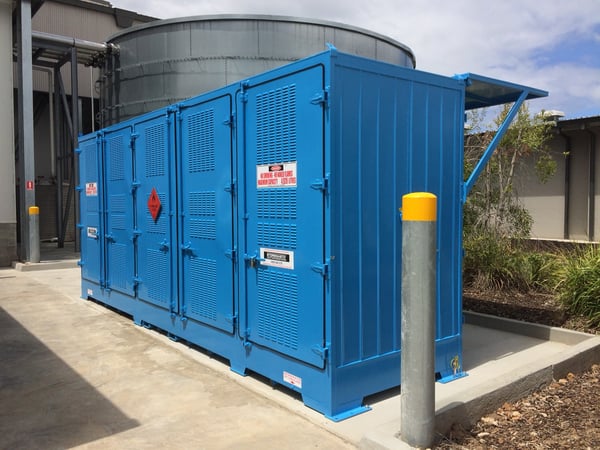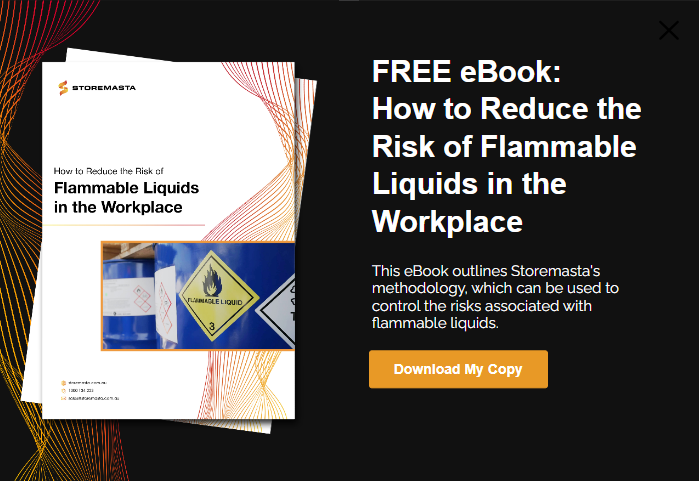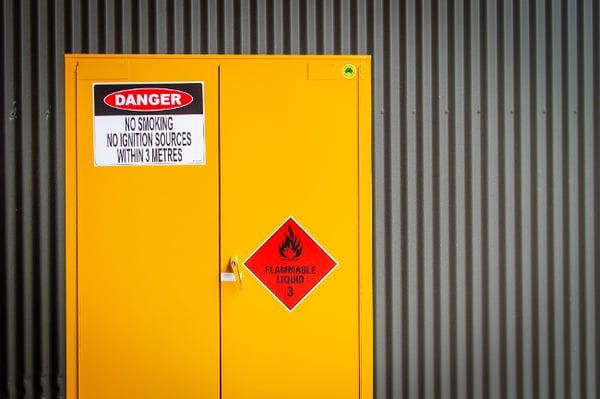As volatile chemicals which can easily ignite in the presence of an ignition source, flammable liquids in the workplace pose the risk of fire, explosion and human harm. When your business is carrying any type of Class 3 Dangerous Goods, a key consideration must be how to ensure flammable liquids are stored in a safe, compliant way. This post will help you create a safer storage environment by explaining the requirements that apply to flammable liquids storage in Australia, including those for minor storage and package stores.
What are the Class 3 Storage Requirements?
To achieve chemical compliance in your workplace, you should be guided by the requirements of the Australian Standards. While the Standards are not law, they are accepted as a solution for meeting the legislative requirements surrounding the storage and handling of dangerous goods. AS 1940 is the Standard that details the requirements for the storage and handling of flammable and combustible liquids. By understanding the various sections of this standard, you’ll be able to adhere to the requirements for minor storage, package storage, storage in tanks, fuel dispensing and emergency management.
In this blog, we’ll be focusing on the requirements for the minor storage and package storage of Class 3 Flammable Liquids.
Minor Storage of Flammable Liquids
Section 2 of AS 1940 outlines the requirements for storing minor quantities of flammable liquids. Minor storage is defined by the class, packaging group (PG) and the location of the storage.
Depending on the packaging group of the flammable liquids that you carry, the requirements are as follows:
Laboratories
- PG I or PG II: 50L per 50 m2 of floor space, or 50 L in a room of up to 50 m2 of floor space
- PG III: 100L per 50 m2 of floor space
Commercial Buildings
- PG I or PG II: 10L per 50 m2 of floor space, but 5 L for any tenancy of less than 50 m2 area
- PG III: 2L per 50 m2 of floor space, but 25 L for any tenancy less than 50 m2 in area
Educational Establishments
- PG I or PG II: 5L per 50 m2 of floor space
- PG III: 10L per 50 m2 of floor space

The minor storage quantities for laboratories and commercial buildings are detailed in Section 2 of AS 1940.
Safety Precautions for Minor Storage
General precautions for minor storage are similar – but not identical – to those for larger stores. As these liquids present a range of dangers, control measures must be applied when storing or handling these dangerous goods.
Some key precautions include:
- Storage areas must be adequately ventilated
- Avoid concentrated storage of liquids in one area to reduce fire risk
- Ignition sources must be isolated
- Incompatible substances require segregation
- Spills must be contained, cleaned-up and disposed of safely
- Ensure vapours and liquids aren’t able to escape to lower levels of your building
- If minor storage is located on a floor above the premise’s lowest floor, the location must not impede evacuation or firefighting operations
- Vapour build-up must be prevented
- Stores must be secured to stop unauthorised entry
- Staff need to be trained on the hazards associated with Class 3 liquids
- Combustible materials and residues must be avoided in minor storage areas
- Packages need to remain closed if not in use
If your quantities of flammable substances exceed those of minor storage, more stringent requirements do apply.
These requirements are outlined in AS 1940 Section 4: Package Storage and Handling Areas. This section of the Standard details the different requirements for both indoor storage and outdoor storage.
We’ll now go into detail about the package storage guidelines for flammable liquids in the workplace.
Indoor Package Storage for Flammable Liquids
When flammable liquids are stored indoors, they can be housed in any of the following package stores as detailed in Section 4.2 Types Of Stores.
These include:
- Detached store
- Attached fire-separated store
- Attached store
- Internal store
- Detached store being a compliant freight container
- Safety cabinet
Due to the practicality and cost-effectiveness of the storage cabinet, the majority of businesses choose this type of store to keep their Class 3 Flammable Liquids.
One popular type of package store is a flammable liquids storage cabinet that’s constructed to meet the requirements of AS 1940.
If you’re choosing a flammable liquids storage cabinet for your business, it must meet the requirements outlined in Section 4.9 of the Standard.
The flammable cabinet requirements include specific details about the cabinet’s:
- Construction
- Marking
- Ventilation
- Location
- Exclusion from ignition sources
- Operation requirements
There are a range of technical construction requirements for flammable storage cabinets to adequately protect people, property and the environment.
Some of these construction requirements include:
- Dual-skinned walls with a 40mm air gap
- Self-closing, close-fitting doors
- Perforated shelving
- Spill containment sump with at least 150mm depth
- Components vital to the structural integrity of the cabinet must not melt at temperatures below 850°C
The cabinet must also have the correct warning and dangerous goods signage. This includes a “Class 3 Flammable Liquids” diamond and a “No Smoking No Ignition Sources within 3 Metres” sign.
Examples of these signs are shown below:
![]() Class 3 Flammable Liquids
Class 3 Flammable Liquids
![]() No Smoking No Ignition Sources Within 3 Metres
No Smoking No Ignition Sources Within 3 Metres
Indoor flammable storage cabinets must also have the provision for mechanical ventilation. They must also be isolated from all ignition sources by at a distance of at least 3 metres.
For the safety of those working with flammable liquids, flammable cabinets must be designed in a way that prevents persons from entering the cabinet. Drums must also be stacked no more than 2 high if they have a capacity exceeding 60 L. This is to stop the drums toppling and causing a chemical spill.
Outdoor Package Storage for Flammable Liquids
There are a number of different ways that flammable liquids can be stored outdoors. However, in all instances, the storage method must meet the requirements outlined in section 4.1 - 4.8 of AS 1940 for it to be compliant.

Chemical storage containers are a safe and compliant method of storing flammable liquids in an outdoor environment.
The safest and most efficient method for storing flammable liquids outdoors is to use a chemical storage container that has been designed and constructed in full conformance to AS1940.
The Standard outlines specific requirements for flammable liquids storage containers which includes details on:
- Spill containment
- Ventilation
- Signage
- Operational requirements
For a dangerous goods container to be compliant, it must have a spill containment sump that has the capacity to hold at least 100% of the largest package stored within the container, as well as 25% of the aggregate capacity of the storage container.
For flammable liquids storage containers storing quantities exceeding 10,000 L, the spill containment sump must have an extra capacity of 10% of the storage capacity between 10,000 L and 100,000 L as well as an extra 5% for capacities exceeding 100,000 L.
Flammable liquids storage containers must also be constructed with a natural ventilation system. This allows the concentration of the flammable vapours to stay at a safe working limit. AS 1940 states that a natural ventilation system must have at least 2 walls of fixed louvers with at least 50% of their area as openings.
For the safety of those staff, supervisors and contractors who are working with flammable liquids, all chemical storage containers must have other operational safety features. For chemical containers storing quantities of flammable liquids exceeding 2000L, a safety shower and eyewash facility that complies with ANSI Z358.1 must be installed next to the storage container.
Packages should also be kept inside the store in such a manner that they are prevented from falling or causing spillage outside the container.
To warn workers of the potential risks associated with flammable liquids, chemical storage containers must be equipped with the correct warning and dangerous goods signage.
The required dangerous goods signage includes a Class 3 Flammable Liquids diamond and the No Smoking No Ignition Sources Within 3 Metres sign — which is also the same signage required for your indoor stores of flammable liquids.
Consider Vapour Concentrations and Ventilation Requirements
As flammable liquids give off flammable vapours, it’s very important to ensure that these flammable vapours are controlled to ensure that they do not come into contact with any ignition sources.
If flammable vapours meet an ignition source, they will ignite and cause a severe fire that could harm the people and property of your organisation. To reduce the risk of fires, it’s very important to ensure that all flammable liquids storage facilities are provided with adequate natural or mechanical ventilation.
The ventilation requirements of your cabinet or store will depend on the type of flammable liquids that your business is carrying. The ventilation system must be able to keep the concentration of flammable vapours within the store below the lower explosive limit. The lower explosive limit is the minimum concentration (as a percentage) of flammable vapours in air that will cause a fire in the presence of an ignition source.
If vapours are emitted from your cabinet or store, they must also fall within the legal limits as stated in the workplace exposure standards. Check the Safety Data Sheets of your flammable liquids to see if the chemicals that you’re carrying are listed in the workplace exposure standards. If they are, you must ensure that any vapours emitted from your store are kept within the legal limits.
IMPORTANT: When a ventilation system is installed on an indoor storage cabinet, the flammable vapours must be dispersed to the outside atmosphere. This outdoor location must be isolated from any type of ignition sources and distanced from any place where people may congregate.
Exclusion of Ignition Sources
Regardless of what quantity of flammable liquids you’re carrying, it’s essential that these volatile substances are kept away from any ignition sources that are present in the workplace.
An ignition source is any object that will provide flammable vapours with enough heat energy to cause a fire.
Ignition sources can come in many different forms — and they are not always as easy to identify as a naked flame or a cigarette butt.
![]()
All ignition sources, including tools, devices and hot work, must be prohibited from flammable liquids handling and storage areas.
Some examples of common ignition sources that may be present in workplaces include:
- Blow torch
- Soldering Iron
- Grinding sparks
- Spark produced from short circuit
Therefore, if you have minor quantities of flammable liquids in the workplace, it’s crucial that you keep them stored in a well-ventilated work area that is at least 3 metres away from any possible ignition sources.
Spill Control
One of the key risks associated with the storage of flammable liquids is fire or explosion caused by a chemical leak or spill.
You must have a spill containment system in place that allows for the successful containment, clean-up and disposal of flammable liquids.
As liquids and flammable vapours can quickly travel through workplaces, any flammable liquid spill must be cleaned up immediately.
Care must be taken to prevent the spilled chemicals (and their vapours) from meeting any ignition sources, incompatible chemicals or combustible materials, such as timber or paper.
Spilled flammable liquids can have severe effects upon the environment, and therefore must be prevented from flowing into any drains, creeks or waterways. If a chemical spill does occur, it can be controlled and cleaned up with a spill kit that contains a non-combustible absorbent such as vermiculite.
IMPORTANT: Even small quantities of spilled flammable liquids have the potential to create a hazardous vapour cloud that can quickly travel considerable distances throughout a workplace. This poses the serious risk of flashback and therefore the chemical spill must be immediately controlled. Ensure you’re equipped with the correct spill kit for clean-ups, as well as preventative measures such as drum or IBC bunding, floor bunding and bunded storage.
Segregate Incompatible Substances
Did you know that there are 9 different classes of dangerous goods — and each class must be segregated from flammable liquids by a certain distance?
If flammable liquids are stored near incompatible substances, they may react dangerously and cause a violent chemical reaction. When storing any class of dangerous goods in the workplace, you must be familiar with the segregation requirements for that particular product.
Flammable liquids must be separated by a distance of at least 3 metres or 5 metres from incompatible substances. You must refer to the dangerous goods segregation chart to ensure that you’re properly segregating incompatible chemicals from your flammable liquids.
However, there is an exception to this rule: If you are using a compliant flammable storage cabinet, the segregation distances may not apply. This is because the dual-skinned steel construction of the indoor flammable cabinet provides adequate segregation from incompatible substances. All other dangerous goods should be stored in a safety cabinet that’s designed and constructed specifically for that class of chemicals.
Fire Protection and Warning Signage
To protect your organisation from any flammable liquid fires that may occur in the workplace, it’s vital that you keep fire extinguishing equipment close to the area where your flammable liquids are being stored.
You should have a least one portable fire extinguisher (that is suitable for the use with flammable liquid fire) adjacent to the area where the flammable liquids are being stored.
In areas where minor quantities of flammable liquids are being decanted, a sign should be displayed to warn of the fire risk.
This sign should display the words:
DANGER - FLAMMABLE LIQUIDS - NO SMOKING - KEEP FIRE AWAY
How are You Storing Class 3 Liquids?
Thanks for reading our post highlighting the flammable liquids storage requirements for Australian workplaces. As we’ve mentioned, it’s crucial that flammable liquids are stored in a safe, compliant manner to prevent incidents such as property damage, environmental pollution and human harm.
If you’d like to learn more about storage solutions that comply with the requirements of the Australian Standard AS 1940:2017, we have an eBook that can help. How To Reduce The Risk Of Flammable Liquids In The Workplace is a practical and easy-to-understand guide that will walk you through the compliant ways you can store your Class 3 Dangerous Goods. Grab your copy for free now.
Joining the team as a Dangerous Goods Storage Consultant, Melissa Hampton became Storemasta's Marketing Manager in late 2021. With extensive knowledge and experience in chemical compliance, Melissa is responsible for leading the Marketing team and helping shape their marketing strategy. In her spare time, you can find Melissa hiking, swimming and enjoying the great outdoors in beautiful north-west Tasmania.

